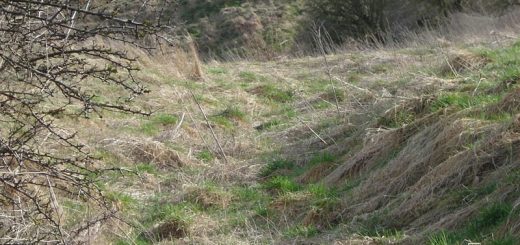Church of St. Meilig, Llowes and Moll Walbee’s Stone
The medieval church of St Meilig was rebuilt in 1853, though the bottom of the tower may be a remnant of the earlier building. Inside the church is a standing stone with a cross carved into it, which possibly dates from the 6th or 7th century. The stone which is thought to have stood at or near the site of a 6th century monastery founded by St Meilig at Croesfeilig. Sometime in the 12th century the stone was moved into the churchyard of St Meiligs’ and then into the church itself in 1956.
 There is a legend associated with the stone and the following version is how it was told in 1881 by Wirt Sykes in his ‘British Goblins’. ‘There are several legends about Mol Walbec’s pebbles in Breconshire. This lusty dame has a full score of shadowy castles on sundry heights in that part of Wales; and she is said to have built the castle of Hay in one night. In performing this work she carried the stones in her apron; one of these — a pebble about a foot thick and nine feet long — fell into her shoe. At first she did not notice it, but by-and-by it began to annoy her, and she plucked it out and threw it into Llowes churchyard, three miles away, where it now lies. In many parts of Wales where lie rude heaps of stones, the peasantry say they were carried there by a witch in her apron.’
There is a legend associated with the stone and the following version is how it was told in 1881 by Wirt Sykes in his ‘British Goblins’. ‘There are several legends about Mol Walbec’s pebbles in Breconshire. This lusty dame has a full score of shadowy castles on sundry heights in that part of Wales; and she is said to have built the castle of Hay in one night. In performing this work she carried the stones in her apron; one of these — a pebble about a foot thick and nine feet long — fell into her shoe. At first she did not notice it, but by-and-by it began to annoy her, and she plucked it out and threw it into Llowes churchyard, three miles away, where it now lies. In many parts of Wales where lie rude heaps of stones, the peasantry say they were carried there by a witch in her apron.’
A later version appears in “Folk-lore and folk-stories of Wales” (1909) by Marie Trevelyan. ‘A stone in Llowes Churchyard, in Radnorshire, has a story attached to it. Maud of Hay, the wife of William de Breos or Bruce, Lord of Brecknock and Abergavenny, was the daughter of Fitz-Walter, Earl of Hereford. The story goes that she built the castle of Hay in Breconshire in a single night, and without assistance. Owing to her occult powers, gigantic stature, and mysterious deeds, people thought she could accomplish any feat, however difficult. In the folk tales and nursery stories of Wales she is known as Mol Walbee, a corruption of her father’s surname, Waleri. While carrying stones in her apron for the purpose of building Hay Castle, a “pebble” of about nine feet long fell into her shoe. At first she did not heed the discomfort, but by-and-by, finding it troublesome, she indignantly threw it over the Wye into Llowes Churchyard, in Radnorshire, about three miles away. It remains there at present.’
Mol Walbec, Moll Walbee, Moll Wallbee or Lady of La Haie (Hay) are all names by which Matilda de Braose (nee de St Valery) (Born 1155 – Died 1210) appears in Welsh legends. She was the wife of William de Braose, 4th Lord of Bramber (Born 1144 – 1153 – Died 9 August 1211), the ‘Ogre of Abergavenny’. She was starved to death with her son William de Braose in Corfe Castle when she and her husband fell out of favour with King John I.























Recent Comments